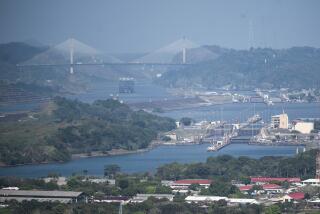Low Waterways Cripple Winter Shipping
- Share via
CHICAGO — The drought of 1988 continues to affect the nation’s two most vital inland waterways, interrupting traffic on the Mississippi River and lowering the Great Lakes, which hold 20% of the planet’s fresh water.
Shallow water stalled traffic on the Mississippi River at St. Louis last weekend, causing a monumental backup of barges and tow boats. At midday Tuesday, in a scene similar to those of last summer, at least 71 tow boats and 840 barges were tied up along the banks. For the first time in four days, the Coast Guard was permitting some traffic to move south as two dredges were in use below the St. Louis harbor.
“You see a lot of sand when you look at the river; the river is just a trickle,” said Jerry Tinkey, president of Mid America Transportation and a former river boat pilot.
“We anticipated that the winter was going to be a killer,” Coast Guard Lt. Cmdr. Myles Boothe said. He said the river at St. Louis was 11 feet below normal Tuesday. “Had conditions been wonderful all year long, then conditions would have been better coming into winter,” he said.
Tinkey, whose company hauls grain, fertilizer and coal between Midwest ports and the Gulf of Mexico, said he expects to have problems all winter along the 180 miles between St. Louis and Cairo, Ill., where the Ohio River flows into the Mississippi.
The drought has reduced water flows from the upper Mississippi and from the Missouri, which empties into the Mississippi just north of St. Louis. Low water also will mean that ice will form easily, an additional hazard to shipping.
Only the lower Mississippi--from the mouth of the Illinois River at Grafton, Ill., to the Gulf of Mexico--is open to navigation during the winter.
So far this year, the drought has cost the barge industry on the rivers of the Midwest an estimated $200 million in revenues and has sharply increased the cost of moving agricultural, coal and petroleum products to market.
Drop From Record Depths
For the Great Lakes, the drought has been a mixed blessing. It has lowered the five lakes from their record depths of 1986, when high water caused hundreds of millions of dollars of damage to shoreline property in seven states and two Canadian provinces.
“It is the biggest drop in such a short period of time in at least 50 years,” Ross Fredenburg of the Army Corps of Engineers said.
Kimberly S. Tassier of the International Great Lakes-St. Lawrence Levels Study Project said that 90% of the drop is due to a lack of precipitation.
In the last 26 months, Lakes Michigan and Huron have fallen more than 3 feet, according to the Corps of Engineers. Lake Erie has dropped more than 2.5 feet; Lake Ontario has fallen about 18 inches and Lake Superior is 10 inches lower than it was in October, 1986.
(To put the loss of water into perspective, the Great Lakes cover 94,000 square miles, or an area about the size of New York, New Jersey, Connecticut, Rhode Island, Vermont, Massachusetts and New Hampshire combined.)
The receding of the lakes has reduced erosion and uncovered beaches and sea walls, but it also has hurt commercial Great Lakes shipping, which is having its busiest year since 1981.
“When the lakes are down so much, the effect is dramatic,” said Glen Nekvasil, communications director of the Lake Carriers’ Assn., whose members haul iron ore, crushed stone and coal.
Lower water levels also mean ships cannot carry full loads at a time of peak demand, Nekvasil said. This year, for example, between 4,500 tons and 17,000 tons of capacity per ship has been lost each month.
To compensate and to meet the demands of a reenergized American steel industry, the Great Lakes shipping season will be extended by about a month, into mid-January. By then ice will block the St. Mary’s River, which links Lake Superior with the other Great Lakes.
Staff writer Art Pine in Washington contributed to this story.
More to Read
Sign up for Essential California
The most important California stories and recommendations in your inbox every morning.
You may occasionally receive promotional content from the Los Angeles Times.










